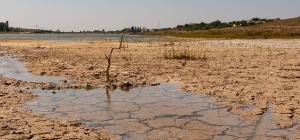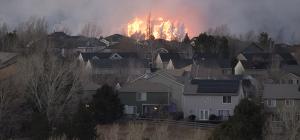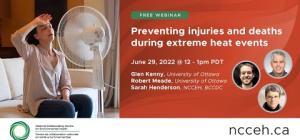
Extreme cold

Climate change is generally expected to lead to warmer winters, while paradoxically, arctic warming is also leading to more extreme cold events. However, defining extreme cold is difficult in a place like Canada, which due to its vast landscape experiences a wide variety of local climates. In some regions, extreme cold alerts are issued for temperatures below -40°C, whereas in other regions, alerts are issued for -2°C or lower. This discrepancy is ultimately a reflection of a region’s overall preparedness for cold, acclimatization of its residents, and wind chill effects. Although Environment Canada has a set of criteria for issuing extreme cold alerts based on region, temperature and wind chill, municipalities may choose to weigh other factors in their decision-making, thus creating a wide variability in when alerts are issued across the country.
The two major health risks of extreme cold are frost bite and hypothermia. While anyone can be at risk, some people are more vulnerable than others, including infants (<1 year), seniors (65+), and people consuming alcohol or nicotine among others. Contextual risk factors can also contribute to a person’s vulnerability to extreme cold; these include spending large portions of the day outdoors (i.e. outdoor workers and outdoor enthusiasts), experiencing homelessness or living in a home without adequate electricity or heat (also known as living in a state of energy or fuel poverty). Cold weather (both moderate and extreme) has also been linked to higher rates of premature death and hospitalization from several causes such as increased spread of infection, and mechanisms that lead to cardiovascular and respiratory events. These causes have been shown to have a delayed effect, occurring several days and up to several weeks after cold weather exposure. There are also indirect health impacts when individuals spend more time indoors that may thereby increase their exposure to indoor health hazards.
The resources listed below are intended to assist environmental public health professionals with the management of extreme cold events, including health and safety precautions to take during cold weather, and considerations for issuing extreme cold alerts.
Selected Resources
Health and safety precautions for extreme cold
- Warming centre guidance (Massachusetts Department of Public Health, Bureau of Climate and Environmental Health, 2024)
This guidance document provides advice and best practice recommendations for US municipalities on setting up a warming centre, which could be adapted to Canadian settings.
- Public health recommendations to reduce the impacts of exposure to winter weather on people experiencing homelessness in British Columbia (BCCDC, 2023)
This guidance document provides information on populations at risk of cold-related injuries due to exposure to cold weather conditions, and advice on preparing, and enacting a winter weather response plan for people experiencing homelessness.
- Severe winter weather and storm preparedness guide (PreparedBC, 2023)
This guidance document available in English, French, Simplified Chinese, Traditional Chinese, and Punjabi provides advice on planning and preparing for winter weather.
- Cold-related emergencies: staying warm and safe in Canadian winters (Canadian Red Cross, 2022)
This webpage provides guidance on how to prevent cold-related health emergencies for yourself, and how to recognize and help others who may be suffering from frost-bite or hypothermia.
- Stay Safe During & After a Winter Storm (Centers for Disease Control and Prevention, 2021)
This webpage provides recommendations on reducing the hazards that can be encountered indoors during an extreme cold event such as carbon monoxide poisoning, smoke inhalation, and fires.
- Cold weather health risks and COVID-19 actions to prevent harm (UK Health Security Agency, 2021)
This slide deck outlines the shared risk-factors of cold-related harms and COVID-19, and proposes several strategies that public and environmental health and housing professionals can implement to reduce these risks.
- Working in extreme temperatures (Government of Alberta, 2019)
This infographic depicts occupational safety considerations of working outdoors in extreme cold temperatures including how to recognize when your body’s core temperature is dropping and precautions employers and employees alike can take to reduce adverse health effects.
- Cold environments- working in the cold (Canadian Center for Occupational Health and Safety, 2019)
This webpage outlines the exposure limits for working outside in cold weather and provides guidance on minimizing cold injury through proper equipment design, safe work practices and appropriate clothing.
- Seven steps to cold weather safety (Government of Canada, 2018)
This webpage describes seven steps you can take to prepare for and manage the adverse health risks of extreme cold.
- Climate change and temperature extremes: a review of heat- and cold-related morbidity and mortality concerns of municipalities (Gronlund et al., 2018)
This narrative literature review examines the social and environmental risk factors that heighten vulnerability to cold- and heat-related morbidity and mortality, and proposes both short- and long-term interventions that can be implemented at the municipal-level to reduce these risks.
- Effects of home energy efficiency and heating interventions on cold-related health (Milner & Wilkinson, 2017)
This review examines the extent to which energy-efficient homes and heating interventions reduce the physical and mental health risks associated with cold temperatures and implications for public health policy.
Considerations for issuing extreme cold alerts
- Criteria for public weather alerts (Government of Canada, 2020)
This webpage outlines Environment Canada’s threshold criteria for issuing extreme cold alerts for different regions in Canada (Table 5).
- Cold weather conditions and risk of hypothermia among people experiencing homelessness: implications for prevention strategies (Zhang et al., 2019)
This peer-reviewed article examines the association between cold weather and hypothermia among the homeless in Toronto. Results indicate that most hypothermic events occurred at temperatures above the city’s extreme cold threshold, suggesting that cold weather responses should be active all winter, and not only during extreme cold events.
- Characterizing the effects of extreme cold using real-time syndromic surveillance, Ontario, Canada, 2010-2016 (VanStone et al., 2017)
This peer-reviewed article investigates three extreme cold alerting algorithms using real-time syndromic surveillance of acute care patients to determine which algorithm best characterizes different populations according to the threshold temperature for which health effects occur.








